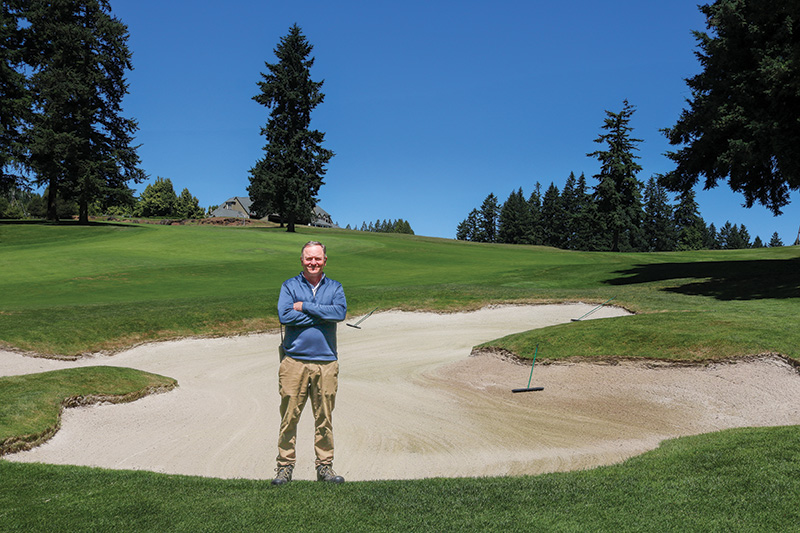
The Oregon Golf Club in West Linn, Ore., has been the home away from home for Russ Vandehey, CGCS, for 28 years. Photo by Gabe Bancroft
His maiden voyage to build something on the golf course was cool stuff for Russell “Russ” Vandehey, CGCS. Until it wasn’t.
We’re talking a long time ago here, way back before he developed as a familiar name in his region. The Vandehey name was well known in Oregon. His family owned some golf courses, including what was known in those days as Bayou Golf Course in McMinnville, Ore. That’s where Vandehey took the initiative to build a tee on a hillside far above a fairway. “It was a great tee location,” Vandehey says.
But …
“Soon, it (his prized tee) was abandoned when we found out that it was on the neighbor’s property,” he says.
That didn’t hold back this up-and-comer. The man who now oversees The Oregon Golf Club in West Linn was inducted in May 2025 to the Oregon GCSA’s Hall of Fame. Vandehey was recognized for contributions to the golf industry and support of industry professional organizations and environmental practices.
And he certainly wasn’t totally discouraged from building things just because that tee from his youth didn’t quite turn out. As he matured and aged, Vandehey would be dogged in how to find a way.
The same goes for bunkers.
With more than four decades in the industry, Vandehey kept trying to get it just right with those. He did. That’s how a 41-year GCSAA member like Vandehey has built a stellar and ongoing career.
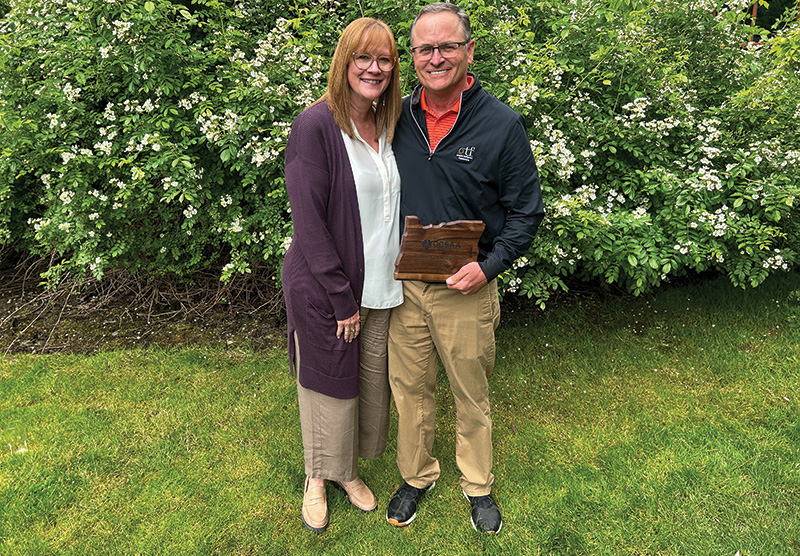
Vandehey was inducted into the Oregon GCSA Hall of Fame this year. Here he is with his wife, Trudy. Photo courtesy of Oregon GCSAPhoto courtesy of Oregon GCSA
Bunker trials and tribulations
Vandehey was hired as a superintendent for the first time at Rippling River Golf near Oregon’s Mount Hood (that was after the Oregon State University graduate spent two months at Waverley Country Club in Portland, Ore.). He spent seven years at Rippling River before leaving to accumulate construction experience at Sandpines Golf Links in Florence, Ore. The Rees Jones design was under construction when Vandehey came aboard. He followed that experience with another course under construction, Druids Glen Golf Club, in Covington, Wash.
Since 1997, Vandehey has been in charge at The Oregon GC in West Linn. It was designed by GCSAA’s 2012 Old Tom Morris Award recipient Peter Jacobsen. Sculpted from an expansive swath of farmland in the shadows of the Cascade Mountains, the 7,052-yard, par-72 layout pays homage to the grand courses of Scotland.
As for the bunker situation, they have changed throughout the years at The Oregon GC. “Back then, you dug a hole and threw sand in it. You used some sand that was topdressing the greens with for the bunkers,” Vandehey says.
In his 28 years at The Oregon GC, Vandehey says that major bunker work has been done twice. Besides the greens, bunkers long have been a frustration for golfers (well, perhaps not for Bob Tway when he holed out of a bunker to birdie the final hole and edged Greg Norman in the 1986 PGA Championship at Inverness Club in Toledo, Ohio).
In 2009, the original bunker liner was installed at The Oregon GC. Its longevity wasn’t as hoped. Vandehey says an issue arose when the fabric liner crept to the surface and caused the staples to be pulled out in the process. Other problems followed. “When it showed its ugly head, we’d cut it (liner) out. We were very disappointed,” says Vandehey.
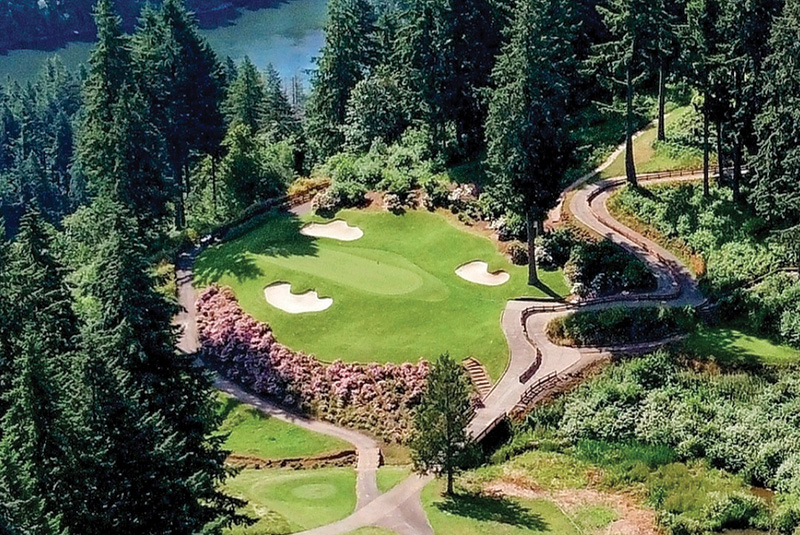
An overhead view of The Oregon GC. The facility was built in 1992.
Time for a change
As an Audubon Cooperative Sanctuary Program, The Oregon GC features bluebird nesting boxes. Other types of birds, though, created bunker issues.
The old porous bunker fabric sometimes was used by crows and sparrows for nests, while other times the birds would fly away with the fabric in tow. “It was a lot of bunkers, a lot of repairs,” says assistant superintendent Scott Olheiser, a 16-year GCSAA member who has been at the club since 2003 after coming there from Pumpkin Ridge Golf Club in North Plains, Ore. “We knew something had to be done.”
Vandehey sought a better way. He made a convincing proposal to the club for a bunker upgrade, including dumping the deteriorating fabric liner. The club agreed, and Bunker Solution was hired. The sand that previously was tan in color was replaced by an off-white color that the company calls sandstone. Bunker Solution — a synthetic bunker-lining system option to prevent contamination of sand, reduce sand mitigation during weather events, reduce plugged balls, hold sand and in turn reduce labor while eliminating the need for gravel that has been used at golf courses such as recent PGA Championship site Quail Hollow Club in Charlotte, N.C. — was implemented 10 years ago at The Oregon GC.
So far, so good. Bunker Solution owner Kevin Clark arrived at the club in 2015 for a few days to help train Vandehey’s crew and guide how to properly install. “It drains well, and the fabric stays in place, stays down nicely,” says Vandehey, adding that overseeing bunkers is less labor intensive than it was several decades ago.
That’s good news to Clark, a former assistant golf course superintendent who launched his business more than 15 years ago. “The Oregon Golf Club was our first job in the Pacific Northwest, which was huge for us,” he says. “He (Vandehey) had some bunker issues, as all superintendents do, but Russ was great.”
Previously, The Oregon GC had 78 bunkers. Today, the total is 45. Whatever the number, Olheiser is happy at a facility that can receive 40 inches of rain. “The sand is more visual and looks better,” says.
Vandehey’s updated bunker scenario a decade ago drew the attention of Randy Shults, CGCS Retired. “We did three redos, rebuilt bunkers. I went to visit him when he last did his. He made changes that helped me. Expectation levels for bunkers have really gone up,” says Shults, a 45-year GCSAA member who ran Tualatin Country Club’s maintenance department for 39 years in Tualatin, Ore. “Randy is the nicest guy you could ever meet. He’s kind. Includes people. He reached out, has gotten people to go play. He makes you feel included in everything.”
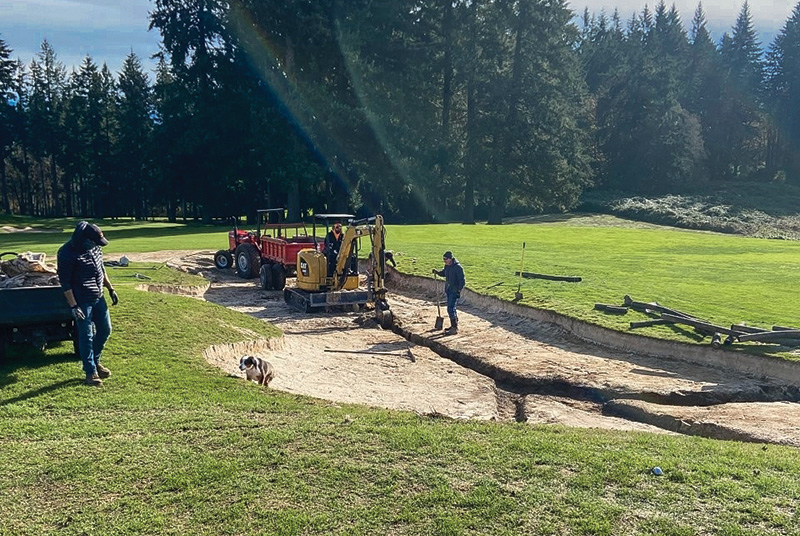
Work on upgrading the bunkers at The Oregon GC began a decade ago. Photos courtesy of Russ Vandehey, CGCS
Family matters
His golf course means everything to Vandehey. His family does, too.
The LPGA Tour’s Cambia Portland Classic was played Sept. 16-19, 2021, at The Oregon GC. It was a shining moment for the place. Vandehey, however, simply had to miss it. He’s got a phenomenal reason why.
“His daughter, Laura, was getting married that week. I ran the entire show,” says Olheiser. “He’s put a lot of trust in what I do. He helps people out. He’s brought in employees that need some help. Former employees have gotten sick, and he goes to visit them. He’s one of the most giving people I have ever known.”
He also is among the most decorated. Vandehey has a slew of GCSAA Environmental in Leadership Award honors: chapter winner in 1999, 2000, 2001, 2002, 2009, 2012 and 2013; and Merit winner from 2005 through 2007. Vandehey has jumped in for many engagements, such as boards and committees for the Oregon GCSA, Northwest Turfgrass Association and Oregon Turf Foundation. His brother, who is 18 months older, GCSAA Class A superintendent Roger Vandehey, a 33-year association member, is proud of him.
“He’s been a good activist. He’s well respected by everyone,” says Roger, now at Middlefield Golf Course in Cottage Grove, Ore., who worked with his brother at Sandpines. He’s a Hall of Famer, and he deserves it.”
OGCSA President Scott Moffenbrier says, “Russ is a true professional who cares deeply for the environment and gives back to the industry in so many ways. I had the privilege of working for him during his first year at The Oregon Golf Club, making this moment (when Vandehey was inducted) especially meaningful.”
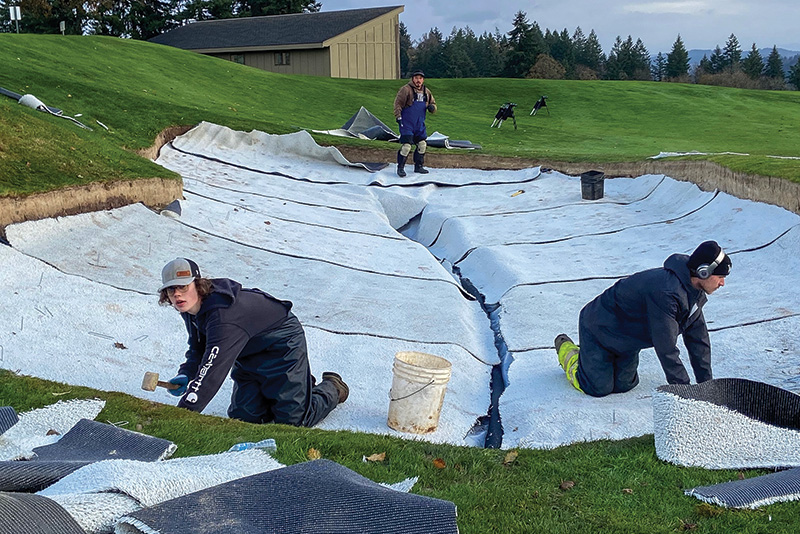
Bunker Solution was hired to set the stage for bunkers renovation in 2015. The work was done in-house.
Bunkers, and life, then and now
The Vandehey brothers grew up playing golf. Russ grew to love the game and the career it spawned for them both.
“We had knowledge of the game,” says Russ, “and back then the superintendent was a farmer that could grow plants.” He has paid back to the industry, not just as a mentor and a veteran superintendent. Vandehey supports the turfgrass program at Oregon State, being active in discussions focused on raising funds to endow an additional turfgrass faculty position at the university. In 2000, Vandehey received the Richard Malpass Distinguished Service Award, which is presented to a person who has given exemplary service to the members of the Oregon GCSA and the industry. Malpass served as GCSAA president in 1976.
“I’m most proud of my involvement in the Oregon GCSA association, working with committees, keeping people involved,” says Vandehey, quite a proponent of the OGCSA, which since 1928 has been a top professional association for men and women who manage golf courses in the Pacific Northwest. Its mission is to provide education, a forum for communication and to serve and enhance the image of its members. “You’re only as good as the membership.”
He might also say you’re only as good as your bunkers.
“Everything now is so much better when it comes to drainage than it was a long time ago,” Vandehey says. “Less standing water than there was 40 years ago.”
What a relief, right?
“That old stuff with bunkers was a challenge,” he says. “Do I sleep better now than in those days because of our bunkers? For sure.”
Howard Richman (hrichman@gcsaa.org) is GCM’s associate editor.






